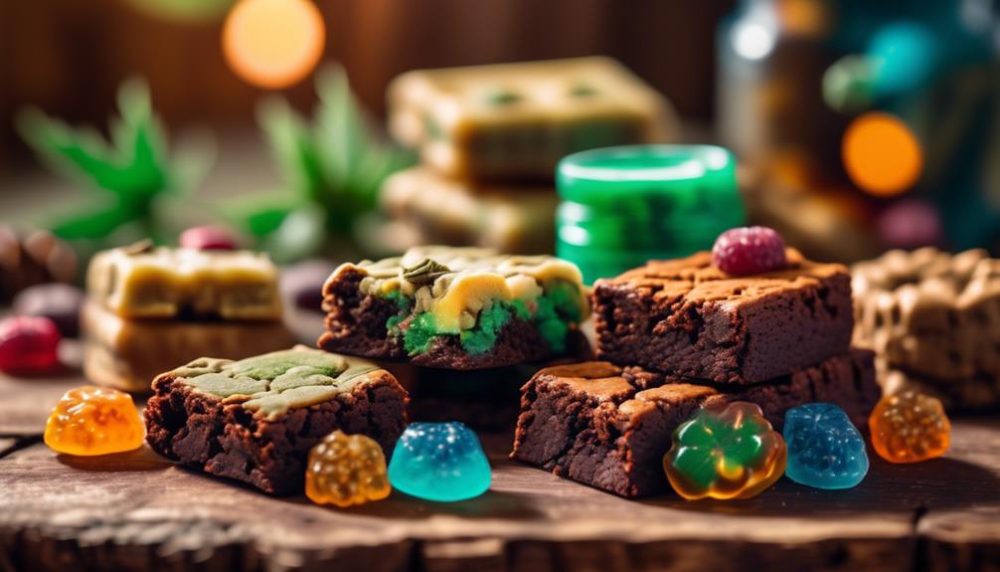
The world of cannabis consumption has evolved significantly in recent years, with a growing interest in edible marijuana products. From delectable chocolates and gummies to infused oils and beverages, the options seem endless.
But what exactly are the benefits and potential drawbacks of munching on marijuana? And is it as tasty as it sounds? In this discussion, we will explore the fascinating history of edible cannabis, delve into the various types available, and examine the health benefits and potential side effects associated with their consumption.
So, if you're curious about whether the world of edible marijuana is as good, bad, and tasty as it seems, keep reading to satisfy your curiosity.
Key Takeaways
- Edible cannabis products have a long history and are available in various forms such as gummies, chocolates, and oils.
- Raw cannabis does not have the same effects as heated cannabis products, which are created through decarboxylation.
- Edible cannabis products are used for medicinal purposes, including treating chronic pain, cancer-related symptoms, and anxiety.
- Overconsumption of edibles can lead to unwanted side effects, so it is important to determine the appropriate dosage and purchase safe, regulated products from licensed dispensaries.
History of Edible Cannabis
Edible cannabis has a rich and ancient history, with evidence of its consumption dating back to ancient times. Cultures around the world have long recognized the cultural significance of cannabis-infused foods and beverages.
Ancient recipes for cannabis-infused drinks, such as bhang in India, have been used during religious festivals for centuries. In China, ancient recipes for tinctures and other edible applications were used for medicinal purposes. These recipes often involved heating the cannabis to activate its compounds.
Today, various types of edible cannabis products are available legally and illegally, including gummies, chocolates, and oils. The popularity of recreational use of edibles in the United States began in the 1960s. While the cultural significance remains, modern edibles have evolved to cater to diverse tastes and preferences.
Types of Edible Cannabis
Various forms of cannabis-infused products are available for consumption, offering a wide range of options for individuals interested in trying edible cannabis. Popular flavors of edible cannabis include chocolate, gummies, and oils. These flavors not only mask the taste of cannabis but also enhance the overall experience.
Different forms of edible cannabis products can be found on the market, such as baked goods, beverages, capsules, and even savory snacks like popcorn and chips. Each form has its own unique characteristics and methods of consumption.
For example, baked goods like brownies and cookies are a classic choice, while beverages like infused teas and sodas provide a refreshing alternative. Capsules offer a discreet and precise way to consume edible cannabis.
With so many options to choose from, individuals can find a form and flavor that suits their preferences and desired effects.
Raw Cannabis and Activation
Raw cannabis undergoes a transformation when exposed to heat, unlocking its full potential and converting certain compounds into their active forms. When cannabis is in its raw form, it contains THCA (tetrahydrocannabinolic acid) and CBDA (cannabidiolic acid), which are non-intoxicating compounds. However, when heated, THCA is converted into THC, the well-known psychoactive compound, while CBDA is converted into CBD, a non-intoxicating compound with potential therapeutic effects. This process is known as decarboxylation.
Eating raw cannabis does not result in a high, as the THC remains in its inactive form. However, some individuals believe that raw cannabis may have unique health benefits due to its rich profile of cannabinoids, terpenes, and other phytochemicals. These compounds are thought to have anti-inflammatory, antioxidant, and neuroprotective properties. However, it is important to note that research on the therapeutic potential of raw cannabis is still limited.
Health Benefits of Edible Marijuana
When it comes to the potential health benefits of cannabis consumption, the activation process of raw cannabis through heat plays a crucial role in unlocking the therapeutic properties of this plant. Edible marijuana products, which have gained popularity in recent years, offer an alternative method of cannabis consumption for individuals seeking the potential health benefits without smoking or vaping. These products typically contain two main compounds: THC (tetrahydrocannabinol) and CBD (cannabidiol). THC is the intoxicating compound responsible for inducing euphoria and relaxation, while CBD is a non-intoxicating compound known for its anxiety-reducing and anti-inflammatory properties. Edible marijuana, particularly those high in CBD, has shown promise in managing chronic pain, a condition that affects millions of people worldwide. While research on the therapeutic potential of edible marijuana is still ongoing, it provides an alternative option for individuals seeking relief from chronic pain.
| THC | CBD |
|---|---|
| Intoxicating | Non-intoxicating |
| Induces euphoria | Reduces anxiety |
| Provides relaxation | Anti-inflammatory properties |
| Potential for abuse | Minimal potential for abuse |
Potential Side Effects
Edible marijuana products, while offering potential health benefits, are not without their potential side effects. It is important to understand these effects before consuming these products. Here are some key points to consider:
- Comparing edible cannabis to other forms of consumption:
- Edible cannabis products take longer to take effect compared to smoking or vaping. It can take anywhere from 30 minutes to 2 hours to feel the effects, as the THC is metabolized in the liver before entering the bloodstream.
- The effects of edibles tend to last longer than smoking or vaping, with some users reporting effects lasting up to 8 hours.
- The high from edibles can be more intense and long-lasting, which can be overwhelming for some individuals.
- Exploring the legality and regulation of edible cannabis products:
- The legality of edible cannabis products varies by country and state. In some places, they may be legal for both medical and recreational use, while in others they may only be legal for medical use.
- Regulations regarding the production and sale of edible cannabis products also vary. It is important to purchase from licensed dispensaries and to be aware of the regulations in your area.
- Other potential side effects:
- Overconsumption of edibles can lead to unwanted symptoms such as anxiety, paranoia, and impaired motor ability.
- In rare cases, edible cannabis products can induce cannabis-induced psychosis, characterized by hallucinations and delusions.
- Other common side effects include dry mouth, sleepiness, changes in visual perception, and potential interactions with alcohol and certain medications.
It is crucial to start with a low dose, be aware of THC concentration, and educate oneself on laws and regulations before consuming edible marijuana products.
Safety Tips for Edible Cannabis Consumption
Understanding the potential risks and ensuring safe consumption practices are essential when it comes to enjoying edible cannabis products.
Common mistakes in consuming edibles include taking too much, not waiting for the effects to kick in, and not being aware of the THC concentration in the product.
To avoid these mistakes, it is important to follow dosage guidelines provided by the manufacturer. Starting with a low dose and gradually increasing if necessary is recommended.
It is also important to be aware of the legal regulations surrounding edible cannabis consumption and to purchase products from licensed dispensaries.
Storing edibles securely, away from children and pets, is crucial to prevent accidental ingestion.
Safety of Eating Weed Vs Smoking It and Purchasing Safe Cannabis Products
The safety of consuming edible cannabis products compared to smoking it and the importance of purchasing safe cannabis products are crucial considerations for individuals interested in exploring the world of marijuana consumption.
When comparing ingestion and smoking effects, it is important to note that inhaling cannabis smoke can negatively affect health, similar to cigarette smoke, and has been associated with lung inflammation, bronchitis, and impaired brain function.
On the other hand, edible cannabis products have not been shown to negatively affect lung health or increase the risk of cancer.
To ensure product quality and legality, it is recommended to purchase edible cannabis products from licensed dispensaries that you trust and to avoid illegal operations or untested products.
Frequently Asked Questions
How Can I Determine the Appropriate Dosage of Edible Cannabis Products?
Determining the appropriate dosage of edible cannabis products can be challenging. Factors such as personal tolerance, desired effects, and potency of the product must be considered. Start with a low dose, wait for the effects, and adjust accordingly for optimal effectiveness and dosage accuracy.
Are There Any Potential Long-Term Effects of Consuming Edible Cannabis Products?
Long-term health concerns associated with consuming edible cannabis products are not well studied due to limited scientific research. However, potential risks may include dependence, cognitive impairment, and respiratory issues. Further research is needed to fully understand the effects of long-term consumption.
Can Edible Cannabis Products Be Used as a Substitute for Traditional Medical Treatments?
Edible cannabis products have shown potential as alternative therapies for certain medical conditions, such as chronic pain and cancer-related symptoms. However, more research is needed to fully understand the effectiveness and safety of these products as substitutes for traditional treatments.
Are There Any Age Restrictions or Legal Limitations for Purchasing Edible Cannabis Products?
There are age restrictions and legal limitations for purchasing edible cannabis products. The specific regulations vary by jurisdiction, but generally, individuals must be of legal age and comply with local laws and regulations to purchase these products.
Can Edible Cannabis Products Be Detected in Drug Tests?
Edible cannabis products can be detected in drug tests, as they contain THC. Potential risks include false positives, impaired cognitive function, and legal consequences. Employers and organizations should have clear policies regarding drug testing and the use of cannabis products.
Conclusion
In conclusion, edible cannabis products have a rich history and continue to be popular today. They offer a variety of options for consumers, ranging from gummies to oils.
While there are potential health benefits associated with edible marijuana, it is important to be aware of potential side effects and consume them responsibly.
When purchasing edible cannabis products, it is crucial to buy from licensed dispensaries to ensure safety. Interestingly, according to a survey conducted by the National Cannabis Industry Association, the market for edible cannabis products is expected to reach $4.1 billion by 2022.
